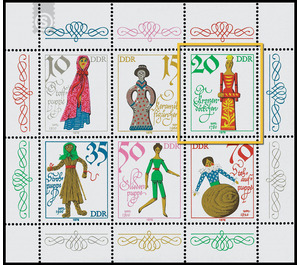Historical dolls - Germany / German Democratic Republic 1979 - 20 Pfennig
Theme: Devices, Items & Instruments
| Country | Germany / German Democratic Republic |
| Issue Date | 1979 |
| Face Value | 20.00 |
| Color | multi-colored |
| Perforation | K 14 |
| Printing Type | offset |
| Stamp Type | Postage stamp |
| Item Type | Stamp |
| Chronological Issue Number | 2216 |
| Chronological Chapter | GER-DDR |
| SID | 638338 |
| In 17 Wishlists | |
Historical dolls With motifs of historical dolls, the Ministry of Posts and Telecommunications of the German Democratic Republic issues six multicolored special postage stamps. The six postage stamps are printed together on a miniature sheet. No special first-day cover envelope Historical Dolls Among all toys, dolls take on a special place as miniaturized images of humans. Playing with the doll, the children creatively shape the environment in which they live, enriching their social environment and enriching their social relationships. Through the design of the doll, society influences the children's play in the sense of its educational and educational goals. Through its wealth of forms, materials and techniques, the doll reflects in its history in many ways the cultural development of human society and bears testimony to the creative abilities of its producers as well as to the very different efforts of society in the play of the child in the course of Story. The bow spans from primitive forms of the doll, which, made from simple materials for their own use, were playing with tribes and peoples on a low level of social development, to the industrially manufactured dolls of our time. The dolls on the special postage stamp miniature sheet have in common that they have been made manually, in manual work for personal use or for sale. The slender wooden puppet with a crown-like head-piece and movable arms, which entered the puppet literature under the name "Kronendocke" or "Zihedocke" (20 pfennig), and was turned and painted in the Sonneberg area in the 18th century, marks the beginning of the Sonneberg dolls. This simple, cone-shaped wooden doll was originally widespread, with details revealing local characteristics. The Sonneberg wooden docks, which are characterized by slender contours, were produced for the market in domestic rural industry with other toys that still show the characteristics of genuine folk art. At the time of this doll's birth, important developments took place in the development of the Sonneberg toy industry, with the aim of increasing the specialization and division of labor of the producers and their separation from the market by merchants and publishers.


